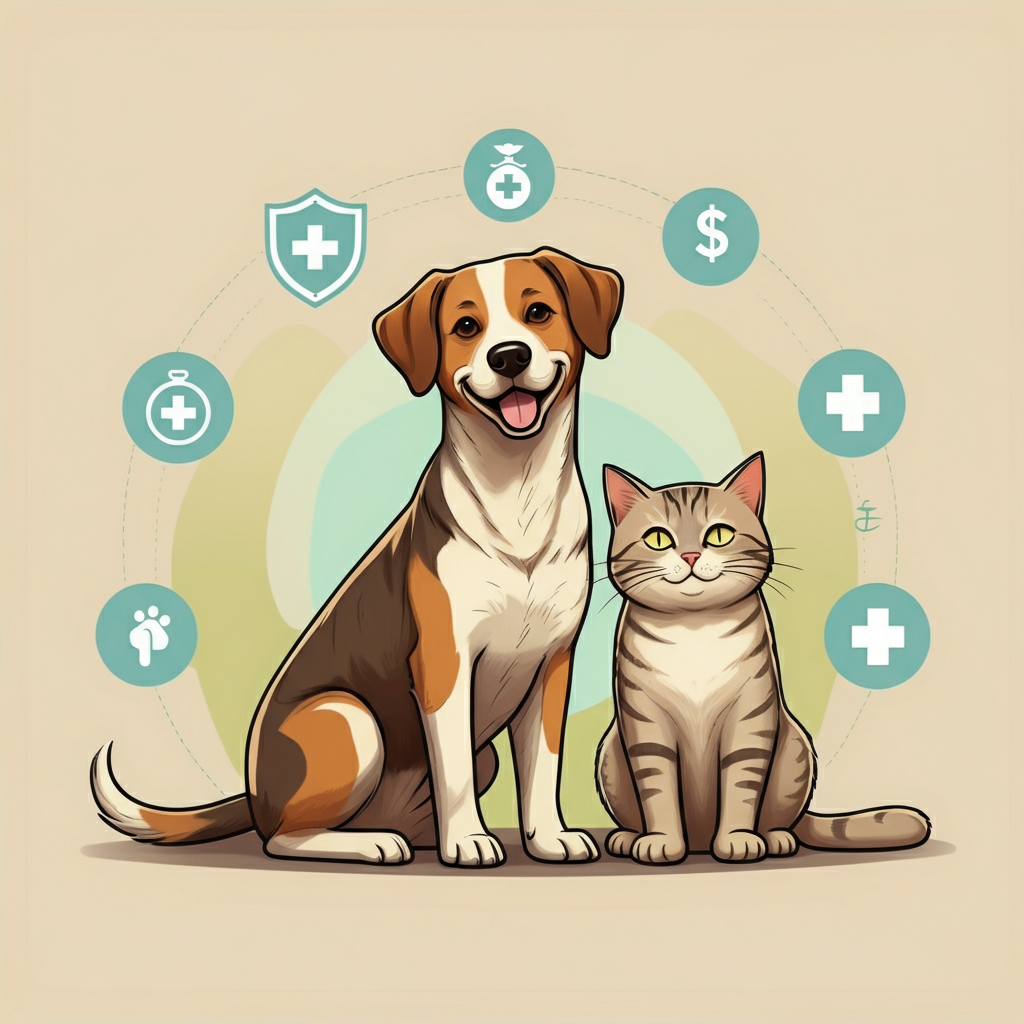Owning a pet fills your life with joy and companionship, but it also brings responsibilities—among them, ensuring your furry friend’s health. Just like humans, pets can face unexpected medical issues, which often result in hefty bills. Pet insurance helps alleviate these financial pressures, letting you focus on caring for your pet instead of worrying about costs.
This guide explains what pet insurance is, the types of coverage available, factors influencing premiums, tips for selecting the right policy, and how to save money without sacrificing protection.
What Is Pet Insurance and Why Is It Important?
Pet insurance is a type of health insurance policy designed specifically for animals. By paying a monthly or annual premium, you can safeguard yourself against the high costs of veterinary care, from routine checkups to serious illnesses or accidents.
Why Pet Insurance Matters
- Financial Protection Against Unexpected Costs
Veterinary procedures like surgeries, diagnostic tests, and prolonged treatments can run into thousands of dollars. Insurance prevents you from having to choose between your finances and your pet’s health.
- Access to Better Care
With the financial backing of an insurance policy, you can access advanced treatments like MRIs, chemotherapy, and specialized surgeries without hesitation.
- Peace of Mind
Pet owners often worry about affording emergency care. Insurance alleviates this anxiety by offering a safety net for unanticipated situations.
- Encourages Preventative Care
Some policies include wellness add-ons that cover regular checkups, vaccinations, and other preventive measures, ensuring your pet stays healthy and happy.
Types of Pet Insurance Coverage
There’s no one-size-fits-all solution for pet insurance. Providers typically offer several coverage options, allowing you to choose one that aligns with your pet’s needs and your financial constraints.
1. Accident-Only Plans
What It Covers:
- Injuries caused by accidents (e.g., broken bones, cuts, poisoning).
- Emergency vet visits resulting from accidental trauma.
Best For:
Pet owners seeking a low-cost option focused on protecting their pets from unforeseen accidents.
2. Illness Plans
What It Covers:
- Diagnosis and treatment of illnesses (e.g., diabetes, infections, or cancer).
- Prescription medications for conditions like arthritis or allergies.
Best For:
Pets prone to genetic or breed-specific conditions, and owners who want protection against unexpected illness-related expenses.
3. Wellness/Preventative Care Plans
What It Covers:
- Routine checkups and vaccinations.
- Preventative treatments like flea/tick control and spaying or neutering.
- Annual dental cleanings.
Best For:
Pet owners focused on preventative care, ensuring their pets stay healthy while minimizing long-term costs.
4. Comprehensive Plans
What It Covers:
- Combines accident, illness, and wellness coverage into a single policy.
- May include additional benefits like behavioral therapy and alternative treatments (e.g., acupuncture).
Best For:
Those looking for all-inclusive coverage to ensure complete protection for their pet, regardless of the situation.
Factors That Influence Pet Insurance Premiums
Several factors impact how much you’ll pay for pet insurance. Having a clear understanding of these can help you budget appropriately and avoid surprises.
1. Pet Age
- Premiums are often lower for younger pets because they are less likely to develop chronic conditions.
- Older pets are viewed as higher risk, resulting in higher premiums and often limited coverage options.
2. Breed
- Certain breeds are more prone to hereditary conditions. For example, German Shepherds are susceptible to hip dysplasia, while Bulldogs often face respiratory issues.
- Mixed breeds usually have lower premiums since they generally experience fewer genetic health issues.
3. Location
- Veterinary costs vary by region, with urban areas typically more expensive than rural ones.
- Higher costs in your area will translate to higher premiums.
4. Type of Coverage
- Accident-only plans are the most affordable, while comprehensive plans are more expensive.
- The more extensive your coverage, the higher your premium.
5. Deductibles and Reimbursement Rates
- Higher deductibles lower your premium but increase out-of-pocket costs during claims.
- A higher reimbursement rate (e.g., 90% instead of 70%) raises your premium.
6. Annual Coverage Limits
- Policies with higher annual limits cost more, but they provide better protection for expensive treatments or prolonged care.
Tips for Choosing the Right Pet Insurance Policy
With so many providers and plan options, navigating pet insurance can feel overwhelming. These tips will help you identify the policy that suits your needs and your pet’s lifestyle.
1. Assess Your Pet’s Needs
- Consider your pet’s age, breed, and medical history.
- For younger pets, prioritize plans with illness and wellness coverage to prevent future issues.
- Older pets or those with pre-existing conditions may benefit from accident-only plans to keep costs down.
2. Compare Providers
- Seek reviews and ratings for customer satisfaction, claims process efficiency, and availability of benefits.
- Get multiple quotes to compare premium costs, coverage inclusions, and add-ons.
3. Understand Exclusions
- Read policy details carefully to identify exclusions like pre-existing conditions, certain breeds, or specific treatments.
- Clarify waiting periods for coverage activation or specific conditions.
4. Evaluate Coverage Limits and Deductibles
- Ensure the policy offers sufficient annual or lifetime coverage for potential major health events.
- Opt for deductibles that align with your financial comfort zone in case of a claim.
5. Look for Customizable Plans
- Many providers allow you to choose deductible amounts, reimbursement rates, and add-ons for dental care or preventative treatments.
6. Speak with Your Veterinarian
- Your vet knows your pet’s medical history and can advise on which coverage features will be most beneficial.
Strategies for Saving Money on Pet Insurance
Although comprehensive coverage can seem pricey, there are several smart ways to reduce costs while still obtaining adequate protection for your pet.
1. Choose a Higher Deductible
Increasing your deductible (the amount you pay before insurance kicks in) lowers your premium significantly.
2. Opt for Accident-Only Coverage
If your pet is generally healthy, accident-only coverage can provide affordable protection against emergencies without paying for illness coverage you may not use.
3. Bundle Policies
Some insurers offer discounts when you combine pet insurance with other policies, such as home or auto insurance.
4. Take Advantage of Discounts
- Look for multi-pet discounts if you’re insuring more than one animal.
- Many providers offer reduced rates for annual rather than monthly premium payments.
5. Keep Your Pet Healthy
- Preventative care, like regular vaccinations and checkups, can reduce the likelihood of needing costly treatments.
- Maintaining a healthy weight and providing a proper diet helps prevent obesity-related complications.
6. Shop Around Regularly
Even if you’re happy with your current provider, it’s worth requesting quotes annually to ensure you’re still getting the best rate.
Final Thoughts
Pet insurance offers pet owners an invaluable safety net, providing financial protection and peace of mind when faced with unexpected veterinary costs. From routine wellness care to emergency surgeries, the right policy ensures that you can prioritize your pet’s well-being without breaking the bank.
Take the time to assess your pet’s unique needs, compare providers, and explore cost-saving strategies to find a plan that offers both quality coverage and affordability. A little preparation today can make all the difference when your pet needs care the most. Ensure your furry companion receives the protection they deserve and the health care they need to live a long, happy life.




